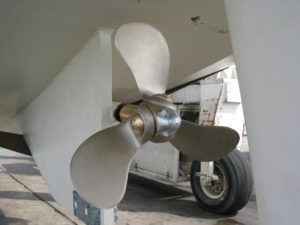Specifying a propeller for your yacht
While the designs of boats and equipment have changed over the years, the propeller configuration remains essentially unchanged. Pitch, diameter, shaft taper details and clearance available are the basic requirements when specifying a propeller. Pitch and diameter are calculated using the maximum engine horsepower, engine rpm and gearbox reductions ratio. The waterline length, beam and displacement are also used to calculate the correct propeller model including the hub and blade configuration. The engineer requires all these details in order to offer you the optimum propeller diameter for your boat.

Folding and feathering propeller types suffer from cavitation compared to fixed propellers because of their functionality and narrow long blades. Depending on the type of installation, excessive blade loading can induce higher noise levels and vibration will be more prevalent. The blades need to fold or swing past each other when going into astern and therefore cannot overlap. The blades are also thick and flat compared to fixed pitch propeller designs, this further reduces the propellers’ efficiency. All told, the design scope is much broader with a conventional fixed pitch propeller. For example, you can modify blade area, pitch distribution, skew, blade rake, diameter and so forth, all of this helps make the propeller work better, given all the design parameters. Unfortunately these elements are not as flexible with sailboat propellers and therefore users sometimes have to accept a compromise when fitting a feathering or folding propeller.
For the very best motoring and sailing performance, one should determine the space available for the largest diameter propeller, allowing for the recommended blade tip clearance. A large slow turning propeller is more efficient over a smaller faster turning one, particularly for a displacement yacht. Unfortunately, sometimes you may not have an engine and gearbox combination to match a propeller of this type and therefore your performance under power would be compromised. To obtain the best solution for any given engine, gearbox combination and yacht you should consult a propeller expert who will carefully consider all the essential elements to a good installation. Don’t be forced to buy a particular brand because it may not be the best solution for your application.
Making the correct choice and comparing the many propeller brands available can sometimes be confusing. Many of the feathering and folding propellers appear quite similar in design and superficially offer similar performance too. The Autoprop is the exception to this, with clear advantages motoring and motorsailing. Try to find independent advice or talk to an existing user of the prop you wish to buy, because the propellers’ performance can very subjective. You need to know the basics and establish your performance criteria in order to find the right propeller for your boat.
